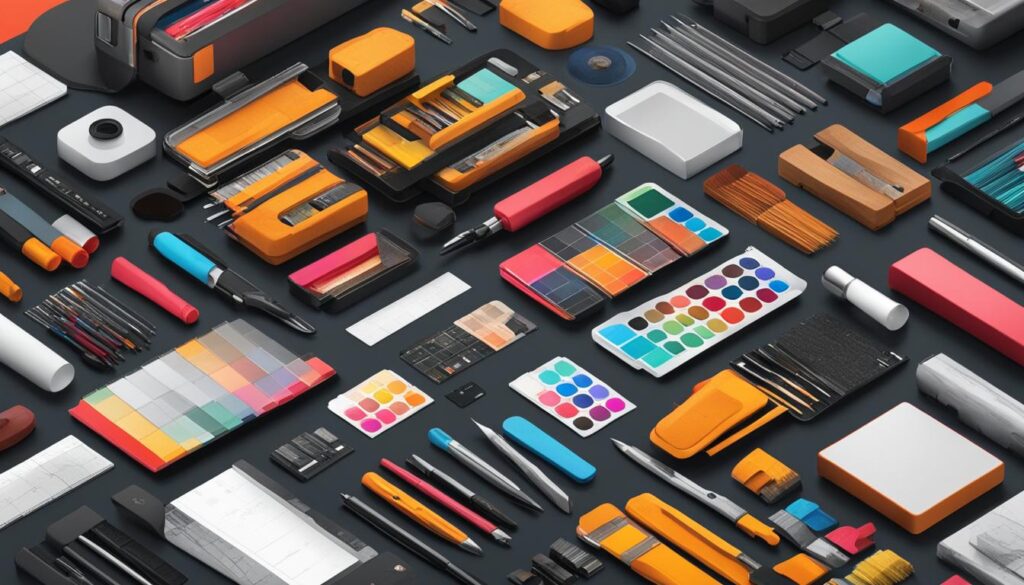
Good web design is crucial for creating a positive first impression and improving the user experience. There are many web design tools available, including graphic design, prototyping, and wireframing options. Factors to consider when choosing a web design tool include ease of use, project type and complexity, collaboration tools, supported platforms, and price.
Key Takeaways:
- Stay ahead in the USA market with top-notch website design tools for success in 2023.
- Choose web design tools based on factors like ease of use, project type and complexity, collaboration tools, supported platforms, and price.
- Graphic design tools like Adobe Photoshop, Adobe Illustrator, and Affinity Designer are popular choices for creating visually appealing web designs.
- For beginners, user-friendly options like Wix, Adobe Dreamweaver, WordPress, and Figma are recommended.
- Professionals can consider tools like Adobe Dreamweaver, Figma, Sketch, and InVision Studio for advanced features and capabilities.
The Best Web Design Tools for Graphic Design
When it comes to graphic design in web design, there are several top-notch tools that professionals rely on to create stunning visuals. From industry giants like Adobe to innovative newcomers, these tools offer a range of features and capabilities to meet the needs of graphic designers. In this section, I will highlight some of the best web design tools for graphic design, including their key features and pricing information.
Adobe Photoshop

Adobe Photoshop is a household name in the graphic design industry. This powerful raster graphics editor is renowned for its extensive photo retouching capabilities and a wide range of features. From neural filters to sky replacement, Photoshop offers everything a graphic designer needs to create visually stunning designs. The software's brushes, content-aware fill, and layer masks provide designers with unparalleled creative control. While Adobe Photoshop comes with a subscription pricing model, its robust feature set and flexibility make it a top choice for professionals.
Adobe Illustrator
Another essential tool for graphic design is Adobe Illustrator. This vector-based graphic design software is perfect for creating logos, icons, illustrations, and more. With its geometric shape manipulation tools and image trace feature, designers can easily create intricate designs with precision. Adobe Illustrator also offers Adobe Capture integration, charts and data merge capabilities, and a 3D panel for added versatility. Like Photoshop, Adobe Illustrator operates on a subscription-based pricing model, making it an investment worth considering for graphic design professionals.
Affinity Designer
Affinity Designer is a rising star in the graphic design world, known for its powerful and intuitive interface. This high-performing graphics editor supports both vector and raster design work, making it a versatile tool for graphic designers. Affinity Designer boasts features like fast performance, zooming capabilities, advanced grids and guides, linked symbols, and live pixel preview. With a one-time payment model and a more budget-friendly price point compared to Adobe's subscription-based software, Affinity Designer offers a cost-effective alternative without compromising on functionality.
Table: Comparison of Key Features and Pricing of Web Design Tools for Graphic Design
| Web Design Tool | Key Features | Pricing |
|---|---|---|
| Adobe Photoshop | Extensive photo retouching capabilities, neural filters, sky replacement, brushes, content-aware fill, layer masks | Subscription-based |
| Adobe Illustrator | Logo and icon creation, geometric shape manipulation, Adobe Capture integration, charts and data merge, 3D panel | Subscription-based |
| Affinity Designer | Fast performance, zooming capabilities, advanced grids and guides, linked symbols, live pixel preview | One-time payment |
With these web design tools for graphic design, professionals can unleash their creativity and bring their visions to life. Whether you choose the industry-standard Adobe software or opt for the more affordable but equally powerful Affinity Designer, these tools provide the necessary features and functionality to create stunning graphic designs for the web.
The Best Web Design Software for Beginners
When it comes to web design, beginners often look for software that is easy to use and doesn't require extensive coding knowledge. Luckily, there are several user-friendly options available in the market. Let's explore some of the best web design software for beginners:
Wix
Features: Wix is a popular website builder that offers an intuitive drag-and-drop interface, allowing users to easily create stunning websites without any coding skills. It gives you access to a huge library of pre-made templates and many ways to change them. Wix also has features like SEO optimization, mobile responsiveness, and the ability to run online stores.
Pricing: Wix offers a range of plans starting from free to premium options, allowing users to choose the one that best fits their needs and budget.
Adobe Dreamweaver
Features: Adobe Dreamweaver is a professional web design software that caters to both beginners and advanced users. It provides a visual interface for building websites, along with code editing capabilities for more customization. Dreamweaver offers features like responsive design, live preview, and integration with other Adobe Creative Cloud tools.
Pricing: Adobe Dreamweaver is available through a subscription-based pricing model, with different plans for individuals and businesses.
WordPress
Features: WordPress is a popular content management system (CMS) that powers millions of websites worldwide. It offers a beginner-friendly interface, a wide range of themes and plugins, and extensive customization options. WordPress also provides features like blogging capabilities, SEO optimization, and e-commerce functionality.
Pricing: WordPress itself is free to use, but additional costs may be incurred for premium themes, plugins, and hosting.
Figma
Features: Figma is a web-based design tool that focuses on collaboration and prototyping. It allows multiple users to work on the same project simultaneously, making it ideal for teamwork. Figma offers a clean and intuitive interface, powerful design tools, and real-time feedback. It is particularly popular among UI/UX designers.
Pricing: Figma offers a free plan with limited features, as well as premium plans for individuals and teams.
Choosing the right web design software for beginners can greatly impact the success of your projects. Consider your specific needs and preferences when evaluating these options, and don't be afraid to experiment with different tools to find the perfect fit for you.

The Best Web Design Software for Professionals
When it comes to web design, professionals require software that offers advanced features and customizable options to meet their specific needs. In this section, I will discuss the top web design software options for professionals, including Adobe Dreamweaver, Figma, Sketch, and InVision Studio.
Adobe Dreamweaver
Adobe Dreamweaver is a widely recognized web design software that caters to professionals with its advanced coding capabilities and flexible design options. With Dreamweaver, professionals can create customized website designs using HTML editing and responsive design features. The software offers a range of tools and techniques to streamline the design process and ensure high-quality results. While Dreamweaver is a paid software, its extensive feature set and robust performance make it a top choice for professionals in the industry.
Figma
Figma is another popular web design software among professionals, known for its powerful prototyping and collaborative features. The software offers a clean and intuitive interface that simplifies the design process, allowing professionals to create visually stunning websites. Figma's real-time collaboration capabilities make it a great tool for teams working on web design projects. Additionally, Figma offers the flexibility to work on both Windows and Mac operating systems, making it a versatile choice for professionals across different platforms.
Sketch
Sketch is a Mac-exclusive web design software that stands out for its intuitive interface and extensive plugin ecosystem. Professionals appreciate Sketch for its user-friendly approach and the ability to create high-quality designs with ease. The software offers a wide range of tools and features tailored to meet the needs of professionals, including vector editing, responsive design, and asset management capabilities. Sketch's plugin ecosystem further enhances its functionality, allowing professionals to customize their workflow and expand the software's capabilities.
InVision Studio
InVision Studio is a powerful web design software that provides professionals with features like artboards, responsive design tools, and smooth animations. The software offers a comprehensive set of tools to streamline the design process and create interactive prototypes. Professionals can take advantage of InVision Studio's collaboration features, enabling seamless teamwork and feedback exchange. With its focus on user experience and design functionality, InVision Studio is a top choice for professionals looking to create dynamic and engaging websites.
Overall, these web design software options cater to the specific needs of professionals in the industry. Whether it's advanced coding capabilities, powerful prototyping features, or intuitive user interfaces, these software options provide professionals with the tools they need to create outstanding web designs.
The Best Web Design Software for E-Commerce
When it comes to building an e-commerce website, choosing the right web design software is crucial. You need a platform that not only offers intuitive design tools but also provides robust e-commerce features to support your online store. In this section, I will discuss some of the best web design software options specifically tailored for e-commerce.
Weebly
One popular choice is Weebly, a user-friendly web design software that comes with built-in e-commerce capabilities. With Weebly, you can easily create a stunning online store and manage your products, inventory, and orders all in one place. It offers features like customizable templates, secure payment options, inventory management, and marketing tools to help you grow your e-commerce business.
Wix
Another top contender in the e-commerce web design software market is Wix. Known for its drag-and-drop interface and extensive customization options, Wix allows you to create a visually appealing online store with ease. It offers features like product galleries, secure checkout, shipping and tax management, and marketing tools to help you attract and retain customers.
Shopify
If you're looking for a more robust e-commerce platform, Shopify is an excellent choice. With Shopify, you get access to a wide range of features designed specifically for online stores. From customizable storefronts to inventory management and order fulfillment, Shopify offers everything you need to run a successful e-commerce business. It also integrates with various payment gateways and offers built-in SEO tools to help you optimize your online store for search engines.
BigCommerce
Lastly, BigCommerce is another popular web design software option for e-commerce websites. It provides a user-friendly interface, extensive customization options, and powerful marketing features. BigCommerce offers features like abandoned cart recovery, product search functionality, multi-channel selling, and advanced analytics to help you drive sales and grow your online business.
Here is a table comparing the key features and pricing of these top web design software options for e-commerce:
| Web Design Software | Key Features | Pricing |
|---|---|---|
| Weebly | Built-in e-commerce capabilities, customizable templates, secure payment options, inventory management, marketing tools | Starting at $6 per month |
| Wix | Drag-and-drop interface, extensive customization options, product galleries, secure checkout, shipping and tax management, marketing tools | Starting at $14 per month |
| Shopify | Customizable storefronts, inventory management, order fulfillment, payment gateway integration, built-in SEO tools | Starting at $29 per month |
| BigCommerce | User-friendly interface, extensive customization options, abandoned cart recovery, multi-channel selling, advanced analytics | Starting at $29.95 per month |
As you can see, each web design software option offers unique features and pricing plans, allowing you to choose the one that best fits your e-commerce needs and budget. Whether you're just starting your online store or looking to scale your existing business, these tools can help you create a professional and successful e-commerce website.
The Best Web Design Software for Non-Coders
Creating a stunning website doesn't have to involve complex coding. There are several user-friendly web design software options available for non-coders that make the process simple and accessible. Whether you're a small business owner, a blogger, or an aspiring designer, these tools offer intuitive interfaces and powerful features to help you bring your vision to life.
WordPress
WordPress is a popular choice for non-coders, offering a range of templates and a user-friendly content management system. With drag-and-drop functionality and a wide variety of plugins, you can customize your website without any coding knowledge. WordPress also provides features like search engine optimization, e-commerce integration, and responsive design options. Pricing varies depending on your needs, from free plans to premium subscriptions.
Wix
Wix is a web design software for non-coders. It has a simple drag-and-drop interface. You can make a professional-looking website quickly. Wix offers a wide range of templates, customizable design options, and features like e-commerce integration, SEO tools, and social media integration. Pricing plans are flexible, allowing you to choose a plan that suits your budget and requirements.
Webflow
Webflow is a low-code/no-code cloud solution that provides a range of templates and customization options. It offers a visual interface that allows you to design and build websites without the need for coding knowledge. Webflow also includes features like responsive design, SEO optimization, and advanced interactions and animations. Pricing plans offer different levels of functionality and support, catering to both individuals and businesses.
Squarespace
Squarespace is known for its professional-looking designs and user-friendly interface. With its drag-and-drop editor, you can easily create a sleek and modern website. Squarespace offers many designs that can be changed to fit your needs, as well as e-commerce integration, SEO features, and analytics tools. There are different pricing plans for online shops, businesses, and personal websites.
Whether you choose WordPress, Wix, Webflow, or Squarespace, these web design software options offer non-coders the ability to create beautiful and functional websites without the need for coding knowledge. You can easily show off your business or content online with their easy-to-use interfaces, templates that you can change, and powerful features.
| Web Design Software | Features | Pricing |
|---|---|---|
| WordPress | – User-friendly interface | – Free plans available |
| Wix | – Drag-and-drop interface | – Flexible pricing options |
| Webflow | – Low-code/no-code solution | – Various pricing plans |
| Squarespace | – Professional-looking designs | – Different pricing options |
Table: A comparison of the best web design software for non-coders, including their key features and pricing options.
Conclusion
Choosing the right web design tool is crucial for creating successful websites. When making your decision, consider factors like ease of use, project type and complexity, collaboration tools, supported platforms, and price. These considerations will ensure that you select a tool that aligns with your specific needs and objectives.
Whether you're a beginner or a professional, there is a wide range of web design tools available to meet your requirements and help you achieve your design goals. For beginners, user-friendly options like WordPress, Wix, Webflow, and Squarespace provide intuitive interfaces and drag-and-drop functionality, eliminating the need for coding knowledge.
For professionals, advanced tools like Adobe Dreamweaver, Figma, Sketch, and InVision Studio offer powerful features for coding, prototyping, and collaboration. These tools are designed to enhance the design process and cater to the requirements of experienced web designers.
By staying up to date with the latest website design tools in 2023, you can stay ahead in the competitive USA market. Whether you're a beginner or a professional, these top-notch tools will empower you to create visually stunning and engaging websites that leave a lasting impression on your audience.
FAQ
What factors should I consider when choosing a web design tool?
Factors to consider when choosing a web design tool include ease of use, project type and complexity, collaboration tools, supported platforms, and price.
What are some popular graphic design web design tools?
Some popular graphic design web design tools include Adobe Photoshop, Adobe Illustrator, and Affinity Designer.
What features does Adobe Photoshop offer?
Adobe Photoshop offers features like neural filters, sky replacement, various brushes, content-aware fill, and layer masks.
What features does Adobe Illustrator offer?
Adobe Illustrator offers features like geometric shape manipulation tools, Adobe Capture, charts and data merge, image trace, and 3D panel.
What features does Affinity Designer offer?
Affinity Designer offers features like fast performance, zooming capabilities, color control, advanced grids and guides, linked symbols, and live pixel preview.
What are some easy-to-use web design tools for beginners?
Some easy-to-use web design tools for beginners include Wix, Adobe Dreamweaver, WordPress, and Figma.
What features does Wix offer?
Wix has a drag-and-drop design that is easy to use and a lot of features, such as the ability to sell things online.
What features does Adobe Dreamweaver offer?
Adobe Dreamweaver is a coding platform for creating customized website designs with HTML editing and responsive design capabilities.
What features does WordPress offer?
WordPress is a content management system (CMS) that lets people use drag-and-drop tools and themes to make websites.
What features does Figma offer?
Figma is an advanced design tool specifically tailored for UI/UX designers, offering a clean interface, online collaboration tools, and web-based accessibility.
What are some web design tools preferred by professionals?
Some web design tools preferred by professionals include Adobe Dreamweaver, Figma, Sketch, and InVision Studio.
What are some web design tools for e-commerce?
Some web design tools for e-commerce include Weebly, Wix, Shopify, and BigCommerce.
What are some web design tools for non-coders?
Some web design tools for non-coders include WordPress, Wix, Webflow, and Squarespace.
What should I consider when choosing a web design tool for my website?
When picking a web design tool for your website, you should think about how easy it is to use, the type of project and how complicated it is, the teamwork tools, the platforms that it works with, and the price.
Which web design tools are recommended for success in 2023?
Stay ahead in the USA market with top-notch website design tools for success in 2023, including Adobe Dreamweaver, Figma, Wix, Shopify, WordPress, Webflow, and Squarespace.











